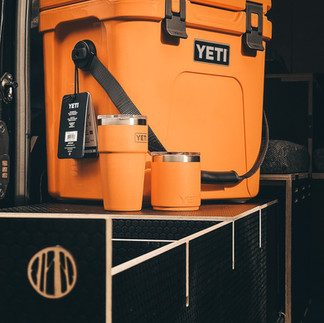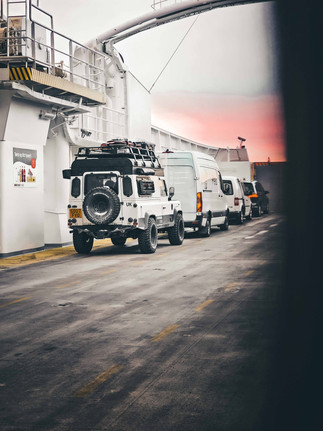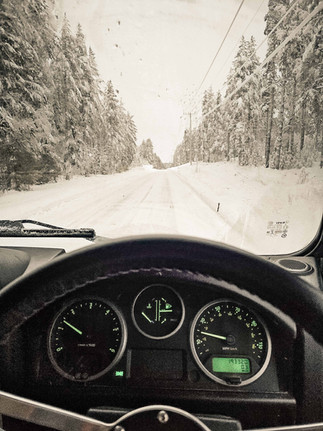Experiencing the Scandinavian Wilderness: A Winter Expedition from Scotland to Norway
- theplyguys
- Mar 25, 2024
- 9 min read
Updated: Mar 28, 2024
Part 1…

Embarking on an overland expedition from Scotland to Norway in the heart of winter is not for the faint of heart. Yet, armed with a freshly “Ply Guy'd" Land Rover Defender, we set out for an unforgettable overland expedition through the frozen landscapes of Scandinavia. Over the course of two weeks, we encountered treacherous roads, navigated through blizzards, endured freezing conditions and immersed ourselves in the pristine beauty of Norway's winter wonderland.
Our trusty steed was something I’ve have an obsession with from an early age, a Land Rover Defender. I was obsessed with them before starting The Ply Guys for their sheer ruggedness and adventure capabilities, but now, we turned this beauty into an overland conquering expedition machine. Its rugged design and off-road capabilities were put to the test as we traversed through icy roads and snow-covered terrain. Over just a few weeks before setting off the vehicle went through rigorous prep, and a full fit out at the farm. This provided us with the comfort and convenience we needed, offering a cozy refuge amidst the harsh elements.

A few bits of info on the vehicle…. She’s my dream land rover… apart from the Series 3 109 which those of you who have recently been to the farm will know is currently sitting in pieces in one of the barns.
The 110… purchased on an accidental whim with a dream of exploring where we never thought we’d get to, it already had an amazing pop top conversion fitted by AW4x4 which meant it was a perfect base to build one of the most capable adventure vehicles around.
The Defender arrived at the farm and had an initial mechanical inspection, as usual with vehicles of this age there was some work to do to get her ready. So… here we go… new turbo actuator wiring harness, MAP sensor, stub axles, rear diff seal, front suspension turrets, brakes all round, new prop shaft UJ’s, oil, and all filters, and some new tyres. These are all fairly easy to undertake with the practical design of the Land Rover Defender, so after all that was done, it was time to sort out the interior… so let’s roll her into the barn….

First things first, I know we design and build innovative campervan furniture, but, we were embarking on an adventure to Norway, it was going to be cold, really cold. Really really cold (can I stress this enough?!). So thoughts turned to creature comforts; heating. The obvious choice was a diesel heater. The considerations were then, where to put it, and how to power it.
Where to put it was obvious at the time, but since arriving back we’ve seen and built conversions in Defenders that utilised a cubby box riser from MUD Stuff, which incidentally fits perfectly with our Gairdean cubby box. Doing the conversion again I would probably relocate it to under the cubby box but I fitted it close into the sidewall behind the drivers seat and underneath the expedition kitchen until that was fitted laterally. Using the MUD Stuff riser would enabled easier ducting into both the rear space and the front cab to aid defrosting in the morning (there was lots of ice, yes, on the inside too, it was flippin cold).

Power – so, here’s where we get a bit inventive and away from the complex campervan “norm”. We’re massive fans of EcoFlow here at The Ply Guys, our workshop vans and show vans run their full systems off them, and so does my other big adventure van (Ford Transit Trail). So this had to be the choice. Inside the front section of the Torridon style Defender bed system is a super handy space to fit an inverter (a Renology 1000W unit). This was wired to the starter battery and provided a switched rapid charge for a “house” EcoFlow, a River 2 Pro. Not the biggest power plant by any means, but it was perfect for the job. Compact, powerful, super fast charging. We could fully charge the EcoFlow within an hour when running the engine. We were overlanding and travelling pretty much every day, so recharging was not an issue, the engine would be on anyway. Make the most of the power your generating, as long as the starter battery is full then we switched on the inverter to top up the EcoFlow. We never ran out of juice, and never had to run the engine at camp to charge or run anything. We were charging cameras, drones, lights, phones, laptops, tablets etc. This can be installed easily in any campervan, we’ve got a few examples at the farm, so come down and check it out. Amazingly easy install compared to the “normal” typical leisure battery campervan set up. The EcoFlow was then wired into a harness for powering interior lights, electric blanket heater, diesel heater, espresso coffee machine and all 240v and USB power outlets. A solar panel went on the roof, topping things up too when the sun was doing it’s thing.
To keep the heat inside the vehicle we insulated and sound deadened the walls, roof and floor, and purchased some great MUDstuff insulated window covers.
Now, plywood, the stuff we love and live by. We schemed, planned, sketched, CAD designed, and manufactured the perfect campervan expedition Defender set up. With a base of our Urlar flooring system elements of our Beinn Land Rover Defender fit out were used to form the campervan interior. The Torridon bed system was perfect, creating ultimate storage space underneath and a huge heavy duty storage drawer for all our heavy gear, and the electrics as mentioned above. Super comfy Harris Tweed upholstery gave our bums a comfy respite from the front seats on long driving days, and a silent night’s sleep on blustery, freezing, dark nights. Paired on the opposite side with our Defender Expedition kitchen unit. Perfect for standard roof Defenders or pop top conversions. Worktop space with room for the Cadac cook 3 pro, Lavazza Espresso Machine, Dometic Hydration system with USB rechargeable tap, pop up sink, all the food, and perhaps the odd bottle of red wine (next to the diesel heater ducting for perfect pre warming!). We knew we were going to be entering extreme cold conditions, so we also had a small electric warming pad which hardly used any power from the EcoFlow to keep the Dometic Hydration pack from freezing. It turns out this was only needs when temperatures were super cold (-5c and above the tank functioned perfectly without the warming pad). Contrary to some other research we also had one for the EcoFlow itself but we didn’t require it, I think charging it most days with the inverter kept it in very good condition in the extreme temperatures.
The underside of the pop top roof received some Ply Guys treatment too, underside cladding with our Croch roof system, albeit a bespoke affair due to the non standard nature of the roof, but perfectly illustrating the functionality and aesthetics of our Suas roof products for other vehicles. Bungee in our case was used to hook lights to and to store the insulated window blinds and hang up jackets and gear to dry after days out in the hills.
A Yeti Roadie 24 was the choice for this expedition, It fits perfectly in-between in the kitchen and bed system, or sits on top of the worktop in the evenings or in bed. In the evenings we would use this as a cards games table, or raclette board. Equally a Yeti Tundra 35 would have done the trick. On cold nights we would actually keep the Yeti cool box outside, which wouldn’t get as cold as actual outside (minus 20 odd) as it would then act as an insulating box, an electric fridge would absolutely not do this. So the Yeti was invaluable. We used a small Yeti ice pack and Norway being Norway this was really easy to refreeze and “recharge” the cool book just stick the ice block outside for an hour to freeze and load it back into the Roadie 24. We were away for two weeks and never had any issues or worries with keeping food fresh. This won hands down over the electric alternative.
The last addition to the cab was our geardean cubby box with two lovely Yeti 20oz rambler mugs, keeping us fueled with caffeine for the whole time we were away.
The roof rack got some custom mounts for ski’s and some storage boxes. One for spares and tools, and the other for additional storage.

The adventure began right from the courtyard at the Farm, driving straight to the overnight ferry from Newcastle to Amsterdam, marking the first leg of our Scandinavian odyssey. Once we touched down in the Netherlands, we drove non-stop from Travemunde to Malmo in Sweden, spending 6 hours in the Land Rover. After an overnight ferry, we were greeted by an amazing sunrise as we entered Sweden and planned to drive North for around 4 hours to a camp spot beside a lake.

However, things were going well; roads were in good condition, and we were making good time. Consequently, the plan changed, and we decided to press on. We continued up the west coast of Sweden through Gothenburg, crossed into Norway, and were greeted by the blanket of snow that enveloped the landscape.

The real challenge began as we navigated through the snowy roads. Even with this vehicle and these tires, snow chains were required on several occasions. Testament to the vehicle, though, it was truly a machine. It coped with everything Norway threw at it. After a 7-hour driving day, we reached a secluded spot near Loten and found our first wild camp spot. It was a perfect snow circle in minus 20 degrees, just in time for dinner (raclette), a game of cards, and a dram to celebrate New Year's in the wilderness. It took us 48 hours from Ply Guys HQ to the Norwegian wilderness.

With the diesel heater on and the Cadac fired up, we found ourselves relaxing in comfort in possibly the most remote location we'd ever been in, facing the most extreme conditions. Despite the challenges, we had a brilliant night. The "Flippy uppy" came into action with the tablet for a film before bed. The cold but calm conditions allowed us to sleep up in the pop-top. Sleeping in these conditions required some thought to get comfortable. Our Harris Tweed cushions served as the base (of course!), but when it's minus 20 degrees, you need to put a little more effort into staying warm, or at least pleasantly not cold.
We were grateful for our 12v electric blanket—a fantastic purchase. Powered from the EcoFlow, we could switch it on 20 minutes before bedtime. Placed below the sheet on the bed, along with a large 13.5 tog synthetic duvet and a woolen blanket, these layers helped trap the heat inside. While socializing and relaxing during the evening, we would have the diesel heater on. However, at night, we preferred to switch it off; it would actually get too warm, believe it or not. The EcoFlow kept the heated blanket running all night long, providing an honestly very cozy experience up in the pop-top.

Morning breaks, marking our first experience of a night this cold. Temperatures plummeted to minus 26°C. First things first: diesel heater on. Then, once I've fully opened my eyes, I realized just how cold it was. Despite the heated blanket keeping us nice and cozy, the extreme cold outside our warm cocoon was very apparent. Everything inside the vehicle had frozen—olive oil, eggs, wine (not for breakfast but from the night before), toothpaste, everything. It hit us harder that these conditions are serious. However, we had prepared properly. The EcoFlow provided us with morning espressos, and the Cadac was ready for porridge, reminding us of home. It was time to pack up camp and head on. We aimed to travel north to Oppdal, so we had some driving to do, and the weather was deciding to take a turn for the worse.
Watch our full Norway video over on our Youtube Channel
Driving on the "main" roads was snowy, very snowy, and the further north we went, the icier they became. Careful driving and concentration were an absolute must. In the afternoon, we drove over a mountain pass, winding our way up a snow-covered back road. We saw what could only be described as a different universe—a snow-capped mountain plateau. Miles away from civilization, some Norwegian roads are serious, usually closed all winter. Unfortunately, we didn't get the memo for this one. A word of advice: don't follow Google Maps in Norway in winter; consult local knowledge, check road status reports, and the weather. We ended up having a small "moment" coming down a hairpin bend off the plateau, and ended up bonnet-first in a huge snowdrift, up to the windscreen. It wasn't the time to get stressed, so we tackled recovery head-on and dug the Land Rover out. Using waffle boards, we managed to reverse her out. Upon closer inspection (by this time it was getting dark), we had managed to dislocate a rear spring on the Land Rover when piling into the snowdrift. Saying that, I truly believe that if we were in any other vehicle, it would have been the end of the expedition damage-wise. Underbody protection guards, tubular bumpers, and the rugged design of the Defender helped us out of the situation almost unscathed. On a steep icy pass, we got the high lift jack and pushed the rear of the Landy into the air, managing to lever the rear spring back into place. Onwards into the night to the next camp.
To be continued in Part 2….
Proud partner of Land Rover Classic
Don't forget to follow us!
Instagram: https://www.instagram.com/theplyguys
Facebook: https://www.facebook.com/theplyguys



























Comments